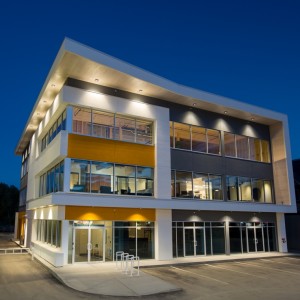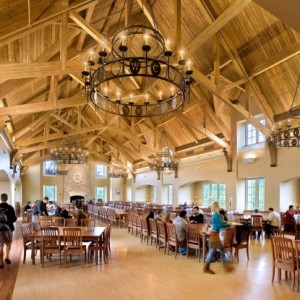A game-changing new system within the mass timber family of construction materials is gaining momentum in America’s design and construction industry, and it’s not hard to understand why. Cross-laminated timber, or CLT, is made from multiple layers of dimensional lumber oriented perpendicular to one another and glued together. It joins some already recognized timber framing components such as parallel strand lumber (PSL), glued laminated timber (glulam), laminated veneer lumber (LVL) and others to make up the “Mass Timber” category of wood construction.

Example of a building framed with glulam post and beam, with Cross Laminated Timber (CLT) making up the floor and roof systems. Photo credit: Structurelam Products
Taking advantage of wood’s inherent structural benefits, the CLT lamination process provides high strength and rigidity in both directions, with the capacity to span significant distance in horizontal applications of floors and roof diaphragms, as well as for shear walls in resisting lateral forces. Construction forecasts predict more mid-rise and high-rise buildings will utilize this approach.
Responsible forestry plays an important role in the sustainability of a future increase in mass timber. Current deforestation and the lack of responsible forestry results in carbon emissions and is not sustainable, while reforestation allows the wood to be sequestered and therefore captures its carbon, in part, through storing it in timber construction. It is also interesting to point out that in using trees that are affected by blight or infestation, we capture carbon that would otherwise be released during decomposition.
Having recently attended the Fay Jones School of Architecture + Design’s “New Languages of Wood” 70th Anniversary Symposium at the University of Arkansas, I am very excited about the latest research on this new wave of wood construction. With Mackey Mitchell’s long history and strength in designing student life facilities, and in particular my involvement with student housing, I envision many benefits of wood and CLT.
I reflect back on my own personal experience transitioning between high school and college – all of the excitement along with the fear of the unknown. My first residence hall experience was not a highlight of my college years, with its concrete masonry walls, plaster ceilings, narrow hallways and dated bathroom facilities. Reimagining it with exposed CLT wood structure ceilings and glulam columns, along with all of the other modern amenities that are now included in current residence halls, I sense a more comforting and pleasant experience.
The qualities and benefits of mass timber wood are numerous, from its strength and surprising fire resistance, to its versatility and sustainability. But what excited me most about integrating wood into student life buildings is its warmth and approachability, its human attraction and natural beauty…the distinguishing characteristics that can make a new student feel comfortable and aid in the transition from mom and dad’s house to a college campus. It’s a small piece of the puzzle, but has the potential to be a very positive one.

 By: Greg Frankenfeld
By: Greg Frankenfeld 